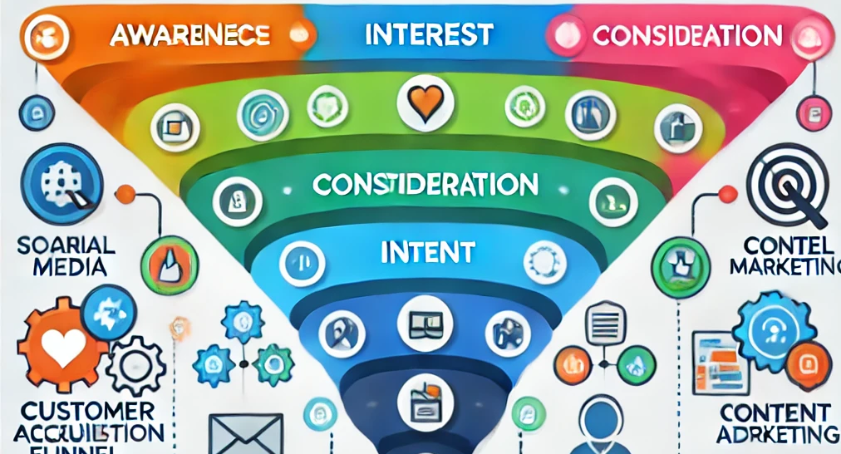In today’s competitive business landscape, understanding and optimizing the customer acquisition funnel is crucial for companies looking to accelerate growth and maximize their go-to-market (GTM) strategies. As consumer behaviors and technologies continue to evolve, businesses must adapt their approach to attracting, engaging, and converting potential customers. This article explores the modern customer acquisition funnel, its role in GTM strategies, and how companies can leverage data and technology to drive sustainable growth.
The Shifting Landscape of Customer Journeys
The traditional customer journey, once a linear path from awareness to purchase, has transformed into a complex, multi-touchpoint experience. Digital channels, social media, and mobile devices have empowered consumers with unprecedented access to information and options. This shift has forced businesses to rethink their approach to customer acquisition.
Key factors driving this evolution include:
- Digital transformation: The widespread adoption of digital technologies has changed how consumers research, evaluate, and purchase products and services.
- Personalization: Customers now expect tailored experiences and communications throughout their journey.
- Omnichannel presence: Businesses must provide seamless experiences across multiple channels, both online and offline.
- Social proof: User-generated content, reviews, and social media influence play a significant role in decision-making processes.
- Data-driven insights: Advanced analytics allow companies to better understand and predict customer behavior.
The Modern Customer Acquisition Funnel
While the basic structure of the funnel remains similar, the stages and strategies within each have evolved to reflect changing consumer behaviors:
- Awareness: In this initial stage, potential customers become aware of a brand or product. Modern awareness strategies often involve content marketing, social media campaigns, and influencer partnerships.
- Interest: Prospects begin to show interest in the product or service. Businesses use targeted content, personalized email campaigns, and retargeting ads to nurture this interest.
- Consideration: At this stage, potential customers are actively evaluating the product against competitors. Case studies, product comparisons, and free trials are effective tools here.
- Intent: Prospects demonstrate a clear intention to purchase. Tailored offers, personalized demos, and abandoned cart reminders can help push customers toward conversion.
- Evaluation: Even after showing intent, customers may still be comparing options. Providing social proof, testimonials, and responsive customer support can tip the scales in your favor.
- Purchase: The customer makes a buying decision. A smooth, frictionless checkout process is crucial at this stage.
- Loyalty: Post-purchase engagement and support are vital for encouraging repeat business and turning customers into brand advocates.
Leveraging Technology for Funnel Optimization
Advancements in artificial intelligence (AI), machine learning, and marketing automation have revolutionized how businesses approach funnel optimization. These technologies enable companies to:
- Personalize at scale: AI-powered tools can analyze vast amounts of data to deliver personalized content and offers to individual prospects.
- Predict customer behavior: Machine learning algorithms can identify patterns and predict which leads are most likely to convert, allowing for more efficient resource allocation.
- Automate engagement: Marketing automation platforms can trigger targeted communications based on specific customer actions or behaviors.
- Optimize in real-time: A/B testing and analytics tools allow for continuous improvement of funnel performance.
- Enhance customer support: Chatbots and AI-powered assistants can provide 24/7 support, answering questions and guiding prospects through the funnel.
Key tools and platforms for modern funnel management include customer relationship management (CRM) systems, marketing automation software, analytics platforms, and customer data platforms (CDPs).
Measuring Funnel Effectiveness: Key Metrics and KPIs
To optimize funnel performance, businesses must track and analyze relevant metrics at each stage. Some critical KPIs include:
- Conversion rates: The percentage of prospects that move from one stage to the next.
- Time to conversion: How long it takes for a lead to move through the funnel.
- Customer acquisition cost (CAC): The total cost of acquiring a new customer.
- Customer lifetime value (CLTV): The predicted revenue a customer will generate over their entire relationship with the company.
- Return on ad spend (ROAS): The revenue generated for every dollar spent on advertising.
- Engagement rates: Metrics such as email open rates, click-through rates, and social media interactions.
- Churn rate: The percentage of customers who stop doing business with the company.
By closely monitoring these metrics, businesses can identify bottlenecks in the funnel and implement targeted improvements.
Balancing CAC and CLTV for Sustainable Growth
The relationship between customer acquisition cost (CAC) and customer lifetime value (CLTV) is crucial for long-term business success. A healthy CLTV to CAC ratio ensures that the company is generating more revenue from each customer than it spends to acquire them.
Strategies for optimizing this ratio include:
- Improving targeting: Use data analytics to identify and focus on high-value customer segments.
- Enhancing customer retention: Implement loyalty programs and personalized engagement strategies to increase CLTV.
- Streamlining the sales process: Reduce friction in the funnel to lower CAC.
- Leveraging referral programs: Encourage satisfied customers to refer others, reducing acquisition costs.
- Optimizing marketing spend: Use attribution modeling to identify the most effective marketing channels and allocate budget accordingly.
Integrating the Funnel into GTM Strategy
A well-designed customer acquisition funnel should align closely with a company’s overall go-to-market strategy. Key considerations for integration include:
- Target market alignment: Ensure that the funnel is tailored to the specific needs and behaviors of your target audience.
- Product-market fit: The funnel should effectively communicate your product’s unique value proposition at each stage.
- Channel strategy: Align your funnel with the most effective channels for reaching and engaging your target customers.
- Pricing and packaging: Ensure that your pricing strategy supports smooth progression through the funnel.
- Sales and marketing alignment: Foster collaboration between sales and marketing teams to create a seamless customer experience.
Industry-Specific Insights
Customer acquisition funnels can vary significantly across industries. For example:
- E-commerce: Focus on reducing cart abandonment and leveraging retargeting strategies.
- B2B SaaS: Emphasize lead nurturing and provide in-depth product education throughout the funnel.
- Financial services: Build trust through educational content and regulatory compliance.
- Healthcare: Address privacy concerns and provide personalized health information.
Understanding these industry-specific nuances is crucial for developing an effective funnel strategy.
Case Study: Spotify’s Data-Driven Funnel Optimization
Spotify, the popular music streaming service, has successfully leveraged data and personalization to optimize its customer acquisition funnel. By analyzing user listening habits, Spotify creates personalized playlists and recommendations, increasing engagement and retention. The company also uses a freemium model to move users through the funnel, offering a free, ad-supported tier to attract users and then encouraging upgrades to premium subscriptions.
Spotify’s approach demonstrates the power of data-driven personalization in modern customer acquisition funnels. By continuously analyzing user behavior and preferences, the company can deliver tailored experiences that drive both acquisition and retention.
Conclusion: The Future of Customer Acquisition
As technology continues to evolve and consumer behaviors shift, the customer acquisition funnel will remain a critical tool for businesses looking to drive growth. Success in this landscape requires a data-driven approach, leveraging advanced technologies and maintaining a deep understanding of target customers.
By focusing on personalization, omnichannel experiences, and continuous optimization, companies can create efficient and effective funnels that not only acquire new customers but also foster long-term loyalty. As competition intensifies across industries, those who master the art and science of customer acquisition will be best positioned for sustainable growth.
Pitch Deck Design Experts play a crucial role in helping companies effectively communicate their customer acquisition strategies to investors and stakeholders, ensuring that the funnel’s importance is clearly articulated within the broader context of the business model and growth plans.
In the end, the most successful companies will be those that view their customer acquisition funnel not as a static tool, but as a dynamic, evolving system that continuously adapts to meet the changing needs and expectations of their target audience.







